How to Deploy CakePHP Application?

This article dives into the nuances of deploying a CakePHP application utilizing a serverless container platform. Starting with a balanced assessment of CakePHP, including its strengths and shortcomings, it then transitions into an in-depth, step-by-step tutorial on CakePHP application deployment.
The guide simplifies the deployment process for novices while also offering value to seasoned developers. Upon concluding this guide, you will gain a comprehensive understanding of how to proficiently use a serverless container platform for your CakePHP applications.
Contents
What is CakePHP?
CakePHP is an open-source web application framework that employs the Model-View-Controller (MVC) architectural pattern. It’s crafted in PHP and is governed by the MIT License.
Providing a foundational architecture for web application development, CakePHP empowers developers by minimizing the need for building from the ground up. Instead, developers can concentrate on the distinctive aspects of their applications by adhering to a series of conventions embedded in CakePHP.
Key characteristics of this framework include the Active Record Pattern for effortless database interaction, a principle of “Convention over Configuration” reducing code volume, a ‘Bake Script’ for automatic code generation, inbuilt validation mechanisms, and robust security measures.
What are the Advantages of Using CakePHP?
CakePHP brings a host of benefits to the table, which has propelled its adoption as a widely utilized web development framework:
- Swift Development Cycle: By embracing the “Convention over Configuration” ethos, CakePHP reduces the redundancy of coding tasks, allowing developers to invest their time in innovative pursuits. Additionally, the ability to generate code accelerates the development timeline.
- Integrated Tools and Resources: With a variety of pre-installed tools for functions such as input validation, SQL injection protection, CSRF security, and form tampering prevention, CakePHP simplifies the process of crafting secure web applications.
- Adherence to MVC Structure: CakePHP’s commitment to the Model-View-Controller (MVC) design pattern facilitates organized code and division of responsibilities, making the management and scalability of applications straightforward.
- Object-Relational Mapping (ORM) Features: The ORM offered by CakePHP enables developers to represent the application’s data model in PHP code instead of SQL, streamlining interaction with databases.
- Broad Compatibility: With compatibility for PHP4 and PHP5 and support for a multitude of database servers, CakePHP exhibits flexibility. Furthermore, it doesn’t necessitate any specialized configuration for setup.
- Open-Source Nature: As an open-source framework, CakePHP is free to use and boasts a vibrant community of developers offering support, tutorials, plugins, and extensions.
- Facilities for Testing and Debugging: CakePHP incorporates in-house tools for testing and debugging applications, fostering code quality maintenance.
However, it’s important to note that while CakePHP offers multiple advantages, the choice of a web framework should be influenced by your project’s specific requirements and context.
What are the Limitations of Using CakePHP?
Despite the multitude of advantages CakePHP presents, it’s worth noting a few constraints that accompany its use:
- Adaptation Phase: For newcomers, mastering CakePHP might pose some challenges. The conventions integral to CakePHP may necessitate a certain learning period.
- Documentation Shortcomings: Although a significant amount of guidance is available, it may fall short compared to the detailed documentation provided by some other prevalent frameworks.
- Performance Constraints: In the case of exceptionally large or intricate applications, CakePHP’s performance may not measure up to some of its counterparts.
- Limited Elasticity: The stringent conventions that CakePHP enforces to expedite development could restrict flexibility. Deviations from these conventions could prove difficult to achieve.
- Excess Overhead: Some developers contend that CakePHP might introduce unneeded overhead, particularly for smaller projects where a comprehensive MVC framework may not be necessary.
- Relative Popularity: While CakePHP has a substantial community, it does not boast the same size or activity level as other PHP frameworks like Laravel or Symfony. This could translate to reduced third-party assistance, fewer instructional resources, and less frequent updates.
However, in spite of these drawbacks, CakePHP remains an efficacious tool for a broad range of web development initiatives. Choosing the right framework invariably hinges on the particular demands and limitations of the project at hand.
How to Deploy a CakePHP Application?
The pivotal phase for any application is deployment, and we’ll delve into the process of deploying an application on the Back4app platform.
What are Back4app Containers?
Back4app containers are instrumental in deploying a multitude of applications, making optimal use of their resources. By employing the Dockerfile, they enable the project to be initiated on remote servers, thereby saving user resources.
Moreover, they allow users to track the progress and monitor the resource consumption of their deployed applications. Back4app containers also simplify the process of redeploying applications when there are new git commits.
Step-by-Step Guide: How to Deploy a CakePHP App on Back4app
We’re about to explore the methodology involved in deploying and building a CakePHP application from scratch, pinpoint the essential prerequisites, and finally walk you through the process of deploying this application on the Back4app platform.
- Sign up or Log in to Back4app Website
First, log in to your Back4app account.

Select the “Continue with Google” option if you already have a Gmail account. Otherwise, use other options.

Users can see all of their recent applications, either backend or container services, in the Back4app dashboard.

To get started with Back4app, the first step is to develop your CakePHP application on your local machine. After that, it’s crucial to upload the application to GitHub. Let’s walk through the necessary steps involved in this process.
- Installation of PHP and Composer Tool
It is necessary to download the PHP for the CakePHP project, so download it from the PHP official website.

Choose the “ x64 Thread Safe” version and download PHP in its zip version.

Extract the PHP’s downloaded zip version after downloading.

After extraction, copy the folder and paste it into the “Program Files” folder in C://drive.

Copy the path of the PHP folder.

Go to the Windows search bar, search for environment variables, and open it.

Click on the “Path” variable in the ‘System Variables’ part.

Click on the ‘New’ button, paste the copied folder path, and click the ‘OK’ button.

Run the following command, ‘php –version,’ in the CMD to verify that PHP has been successfully installed on your device.

PHP has been installed. Now download the ‘Composer’ management tool from the following link. Step forward and press the ‘Download’ button.

Select the “Composer-Setup.exe” option to auto-download it.

Open the downloaded composer’s .exe file.

Installation popup will open, and then press the ”Next” button.

Select the installed PHP path from your local device and click the ‘Next’ button.

Press the “Install” button to install the Composer on your device.

The composer installation has been completed now. In the end, click the “Finish” button.

Run the following command, ‘composer,’ in the CMD to verify that it has been successfully installed on your device.

- Setup the Configurations for CakePHP
To proceed, we must first adjust certain settings by uncommenting a few lines of code in the “php.ini” file. Navigate to the PHP directory located in the “Program Files,” and then open the php.ini file with your text editor.

Uncomment the ‘extension=intl’ line with removing a semicolon at the beginning of the line.

Uncomment the ‘extension=mysqli’ and ‘extension=pdo_mysqli’ lines with the removal of a semicolon at the beginning of the line.

Uncomment the ‘extension=sqlite’ and ‘extension=pdo_sqlite’ lines with the removal of a semicolon at the beginning of the line.

- Create a Project with CakePHP Framework
Create a new folder named ‘cakephp1’ in your drive.

Go to the Windows search bar and open Visual Studio Code.

Visual Studio Code tool has been launched.

Open folder ‘cakephp1’ in your VS Code.

Click on the “Terminal” option showing at the top bar menu.

‘New Terminal’ has been opened.

Run the following command with the composer to create a new CakePHP app named ‘my_cakephp_app’ in the cakephp1 folder.

The CakePHP app has been created.

Move the pointer to the CakePHP project using the ‘cd’ command.

Run the ‘bin/cake server’ command to launch the CakePHP project. Click on the localhost:8765.

The CakePHP application will be launched.
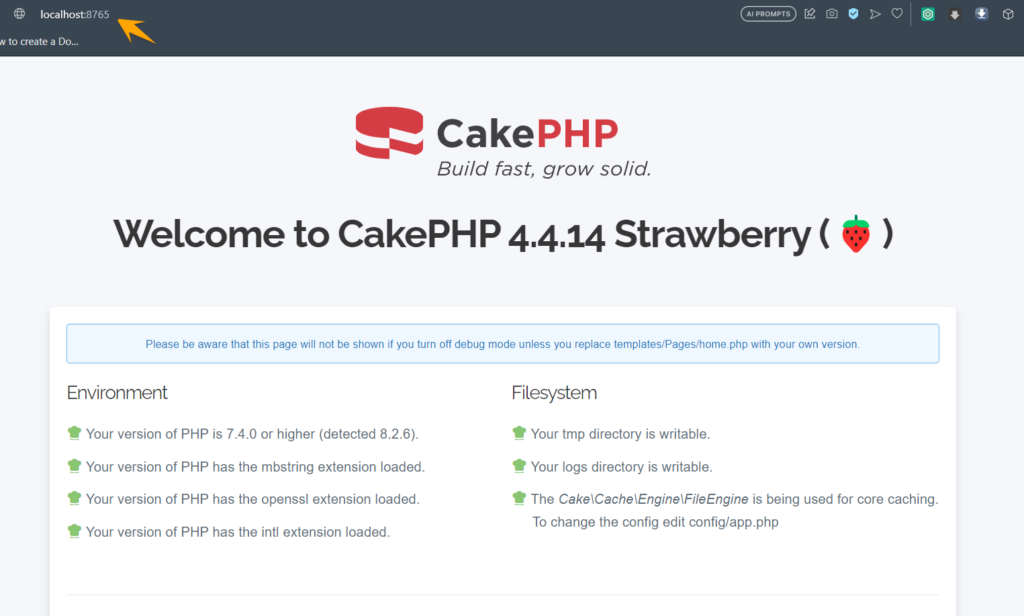
- Dockerize the CakePHP Project
Create a ‘Dockerfile’ in the CakePHP project.

Open Dockerfile and write the following code snippets in it.
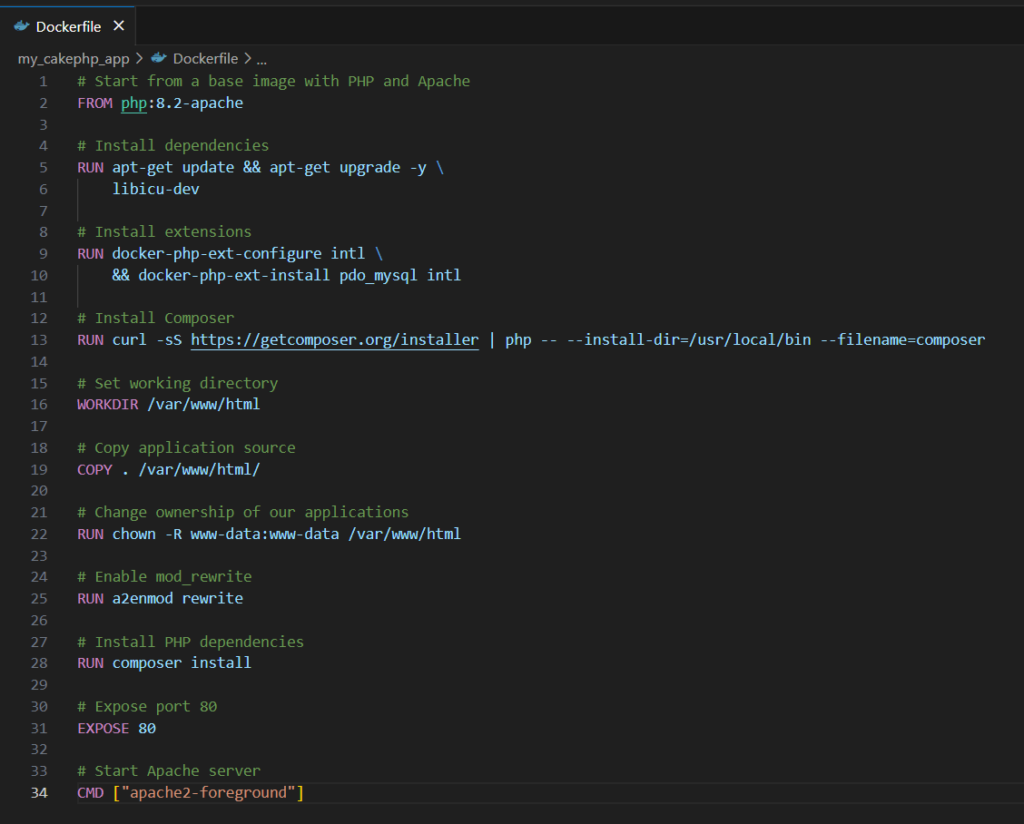
Run the following command to build the Docker image of your CakePHP project and assign a name ‘my-cakephp-app.’

Execute the ‘docker run’ command to deploy the Docker image within the Docker container.

Open the Docker Desktop, and you will see the image of ‘my-cakephp-app’. Click on the port to run the application in docker containers.

The CakePHP project ran successfully after dockerization.
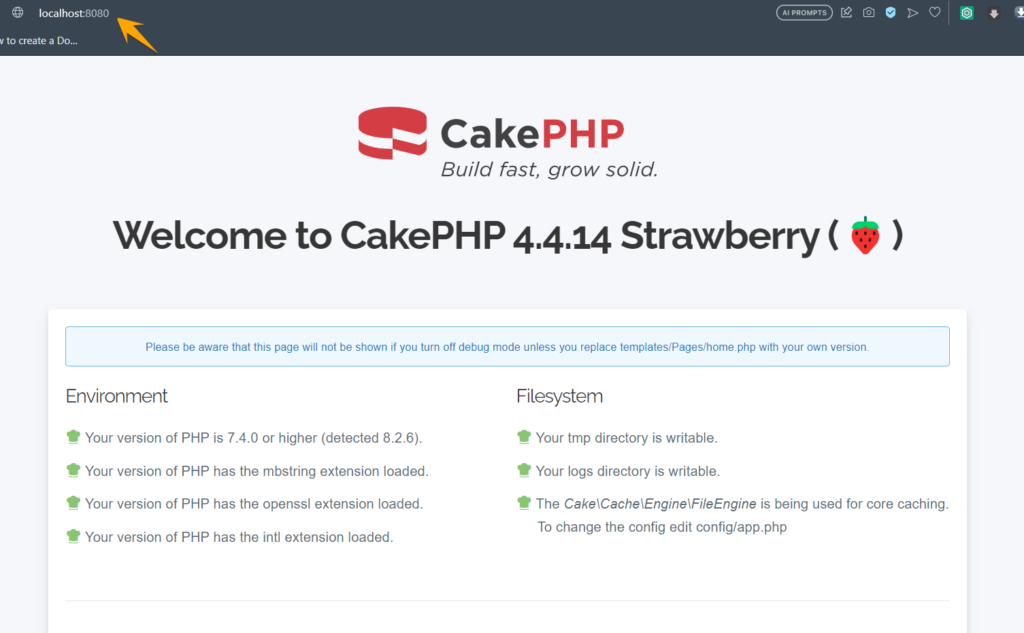
- Git Repository Creation and Pushing CakePHP Project
Go to GitHub and log in to your account.

Sign in using your credentials.

Make a new repository by pressing the ‘New’ button.

Assign the name ‘cakephp’ to this repository.

Build a repo by clicking on the ‘Create Repository’ button.

Go to the CakePHP project, open the Terminal, and initialize Git.

Add the ‘my_cakephp_app’ project to Git.

Commit the project’s code.

Set the branch name, origin, and then push the repository code to GitHub.

The CakePHP repository has been pushed.
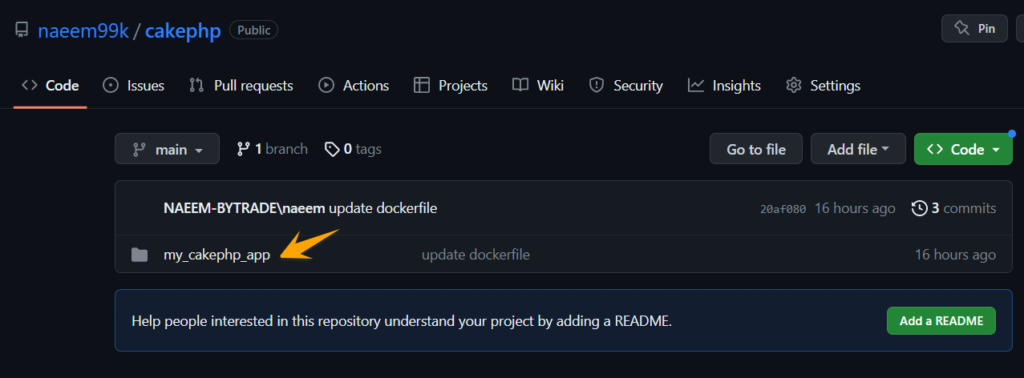
- Build a New App using Back4app Containers and Integrate with CakePHP
As we have already signed in to the Back4app platform, press the “NEW APP” button.

Choose the Back4app containers as a service option.

Selecting the container’s service will display the new screen with all projects.

Click the ‘Edit Github Permissions’ button to migrate the GitHub CakePHP project into Back4app.

Select the ‘cakephp’ repository and press the green ‘Save’ button.

The GitHub repository ‘cakephp’, along with code has been pulled into the Back4app platform.

Now click the ‘select’ button to link this project to a new container app.

Assign the ‘App Name’ branch will be pre-defined as ‘main’ and assign the name of the main project directory where the Dockerfile exists.

In the end, click on the ‘Create App’ button.

The container services get started and install the relevant dependencies for the CakePHP project.
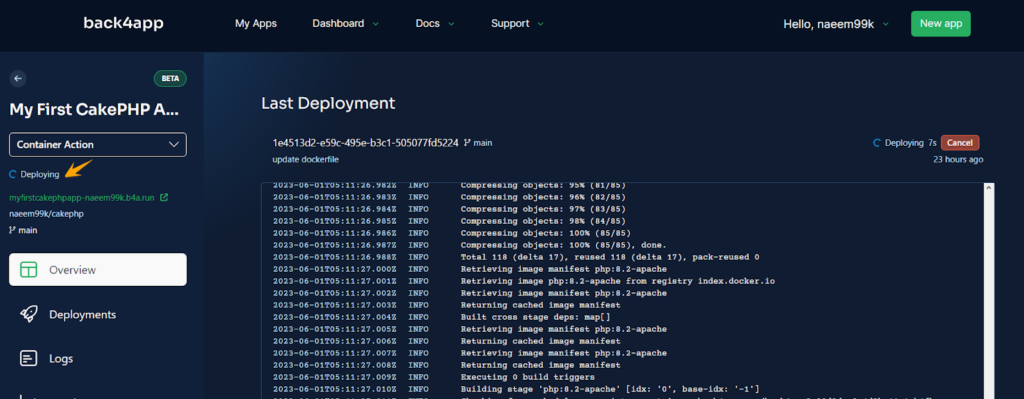
Click on the highlighted green link to view the CakePHP application.
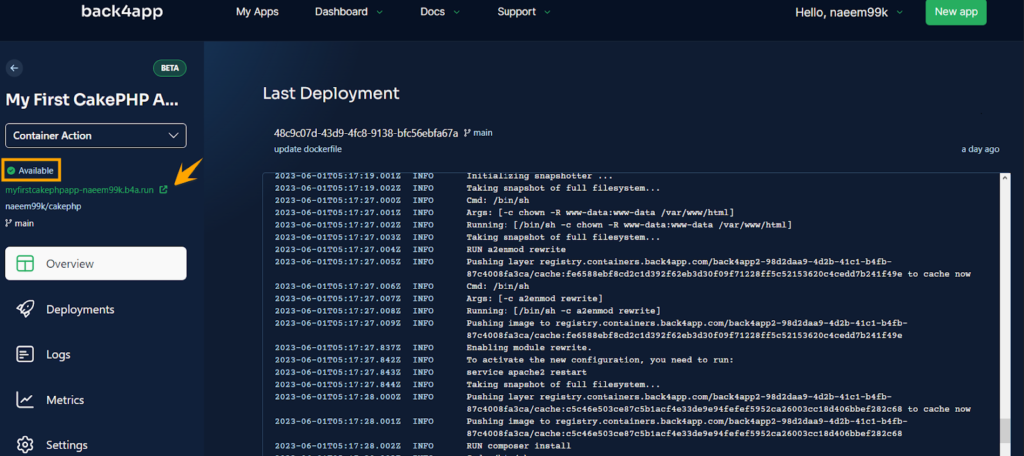
The CakePHP application has been running on the Back4app containers successfully.

Conclusion
In the realm of web development, resources like CakePHP and Back4app have proven their merit by facilitating the process of app creation and launch.
Nevertheless, the selection of these tools should be driven by the unique requirements of every project. Despite the numerous benefits that CakePHP and Back4app bring, they also bear certain shortcomings that could affect their utility in specific circumstances.
Thus, a judicious choice necessitates thoroughly assessing each tool’s advantages and drawbacks. Equipped with a detailed knowledge of these platforms, you are ready to make choices that could significantly influence the outcome of your web application ventures. The domain of web development is ready for your next outstanding application!
FAQ
What is CakePHP?
CakePHP is a robust open-source PHP framework, widely used for web application development, known for its rapid building process and MVC architecture.
What are the advantages of CakePHP?
– Swift development
– Tools and resources
– Open Source
How to deploy a CakePHP application?
– Choose the deployment platform
– Install PHP composer tool
– Setup configurations for Cake PHP
– Have the code on GitHub
– Deploy the GitHub code



